The Cosmic Microwave Background (CMB) is the name given to the radiation that is the afterglow of the Big Bang event. Now stretched, from the expansion of spacetime, to the microwave end of the electromagnetic spectrum where we observe it coming from all heavenly directions. It was the discovery of this afterglow that caused the Big Bang theory, as originally proposed by Georges Lemaître, to become the dominant cosmological understanding of how our universe began.
Initially at first, the measurement of this radiation showed a uniform and homogeneous temperature. But with the development of better and more sensitive mapping experiments variations in this uniform map were discovered. The Balloon Observations of Millimetric Extragalactic Radiation ANd Geophysics (BOOMERanG’98) was one of the first such experiments. NASA’s Wilkinson Microwave Anisotropy Probe (WMAP) and later the ESA’s Planck space observatory produced even more detailed maps showing variation.
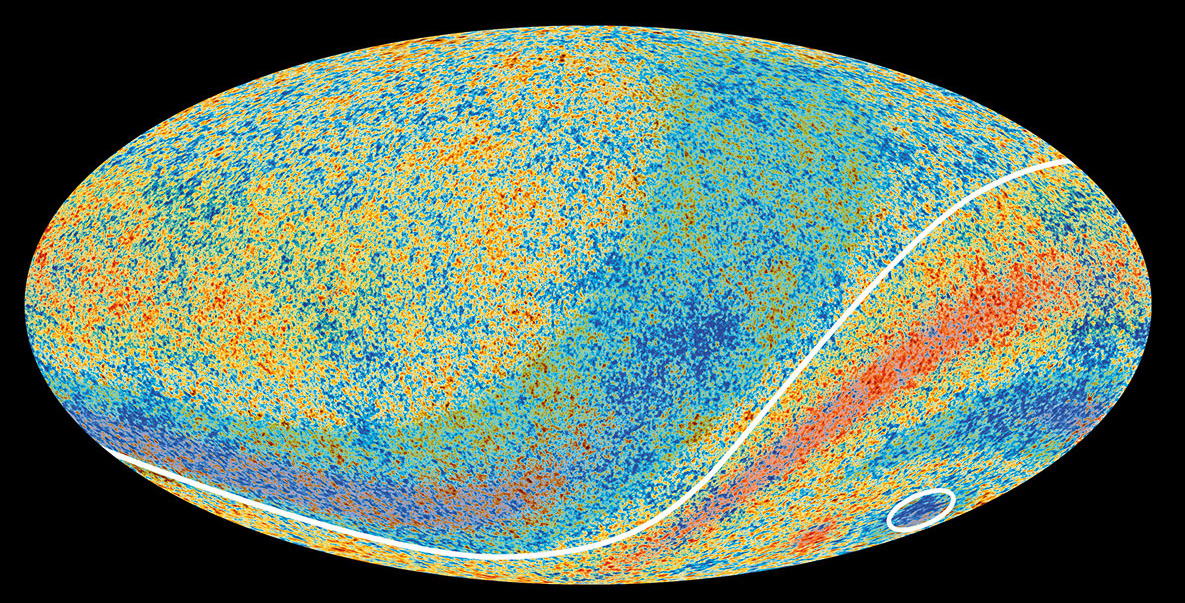
Arctic anomaly: A map showing the cosmic microwave background (CMB) temperature as observed by ESA’s Planck satellite. While fluctuations in the CMB were expected, and were observed by Planck, an unforeseen anomaly is the cold spot (circled), which extends over a large patch of sky and has a much lower temperature than expected. (Courtesy: ESA/Planck Collaboration)
The maps of the CMB produced by these experiments showed a near homogenous temperature distribution from the microwave blackbody radiation. The mean temperature of the microwave background sky is 2.72548K with an average variation of \( 18{\mu}K \).
However both the maps produced by the WMAP and Planck missions showed an area in the southern hemisphere whose temperature is significantly much cooler than the rest of the map. Located in the direction of the Eridanus constellation, in the southern hemisphere, this cooler region became known as the CMB Cold Spot. The temperature in the CMB Cold Spot is \( 70{\mu}K \) cooler than the surrounding areas. [1] [2]
In effect, the temperature variation seen on the CMB maps corresponds to the distribution of matter and energy throughout the universe. The higher the temperature in a given area the greater the density of matter in that area. So a region of high temperature in the CMB correlates to a region of the universe where galaxies are grouped together forming superclusters. On the other hand a region with a lower temperature correlates to a region of the universe with fewer galaxies.
So the presence of the CMB Cold Spot indicated the presence of a supervoid which has come to be known as the Eridanus Supervoid or simply the Great Void.
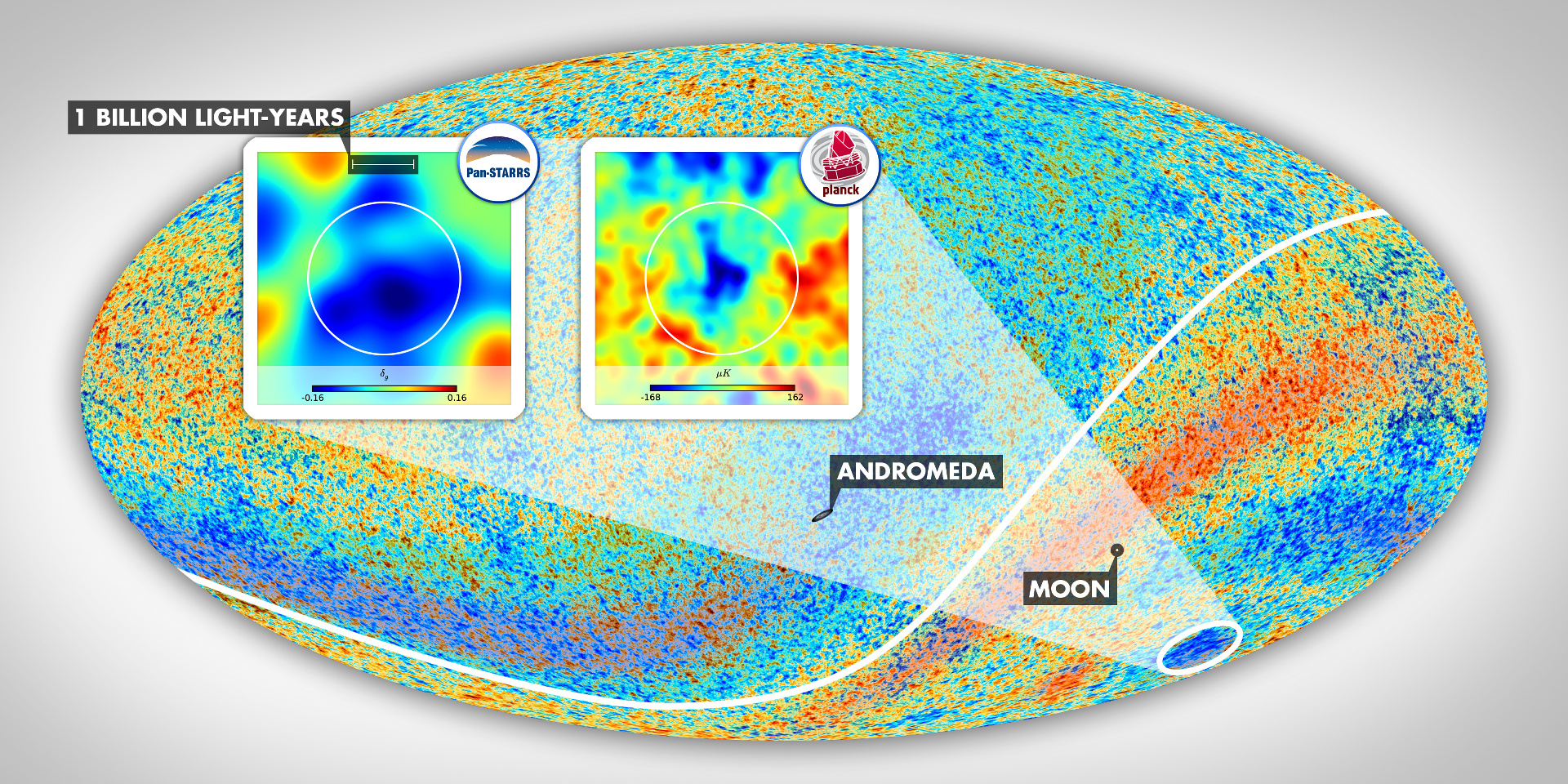
The Cold Spot area resides in the constellation Eridanus in the southern galactic hemisphere. The insets show the environment of this anomalous patch of the sky as mapped by Szapudi’s team using PS1 and WISE data and as observed in the cosmic microwave background temperature data taken by the Planck satellite. The angular diameter of the vast supervoid aligned with the Cold Spot, which exceeds 30 degrees, is marked by the white circles. Graphics by Gergő Kránicz. Image credit: ESA Planck Collaboration. [3]
The discovery of the Bootes supervoid was very problematic to the Lambda-CDM model because it ran in direct violation of the current standing cosmological principle: Namely, that at sufficiently large enough scales the universe is both homogenous and isotropic. The initial complete uniformity of the very first maps of the CMB reenforced this belief.
Simulations of cosmic voids: This 2012 simulation of voids, based on the Lambda-CDM model, merging as cosmic structure evolves is now borne out by data from the Sloan Digital Sky Survey. Credit: J. Hidding, R. van de Weygaert, Univ. Groningen [4] [5]
According to the Lambda-CDM model a supervoid is formed from the aggregation of smaller voids that over time grow to become larger and larger voids. Voids are considered to be filled with a mysterious form of energy dubbed dark energy. [4] [5] [6] [7]
The idea behind dark energy is that firstly like dark matter we know something is there because we can see its effect. The problem is we are unable to see it and have no idea what it actually is. Secondly, unlike dark matter which has a gravitational attraction; dark energy acts an anti-gravity force in that it repels objects with mass, such as galaxies.
Now in the context of the Big Bang Hypernova Hypothesis dark energy is seen as coming from that matter which both belongs to the SuperVerse and effectively has mass inside the SuperVerse. So the MacLean inside the Bootes SuperVoid is a starlike object whose matter has both weight and mass when viewed from the prospectus of an observer inside the SuperVerse. Remember that self-similar patterns repeat themselves so by taking the behaviour of matter with mass inside our universe we try to imagine the equivalent existing at the larger scale inside the SuperVerse.
So if we imagine our universe as a balloon being inflated inside a room then from “the prospectus of an observer inside the SuperVerse” would be equivalent to standing inside the room watching the balloon being inflated. To actually be an observer inside our universe we would have to be inside the balloon that is being inflated.
In previous work, I laid out the idea that “gravity is equivalent to the electric force, but on the next scale up”. That is, the force we know as gravity inside our universe is equivalent to the electric force, on the next scale up, when observed from the prospectus inside the SuperVerse. As like electric charges repel one another a solid object is given form because of this repulsion between the orbital electrons in atoms. I cannot walk through a solid wall because to me, at the human scale, it is solid. However, remember that nearly all the space inside an atom is empty; 99.9999999999996% empty space in the case of a hydrogen atom. The solidity comes from the repulsion between the negative charged electrons arising from the electric force.
So by the same interaction, inside the SuperVerse, its equivalent to the electric force would imbue solidity by repulsion within the SuperVerse. That solidity would thus be seen as gravitational repulsion, or anti-gravity, to us inside our own universe. Hence the effect we currently know as dark energy arises from the repulsion of objects from the prospectus of the SuperVerse.
However, in the context of the Lambda-CDM model, the concept of the SuperVerse has no sense or meaning. This is because of the fatal assumption that everything that has ever existed and will be; be it space, time, matter or dark energy; did not exist before the Big Bang. That is, like everything else, the matter that gives dark energy form was contained inside the Big Bang. It does not exist as an external component; according to the Lambda-CDM model.
So in the context of the Lambda-CDM model dark energy is seen as being scattered evenly throughout the very early universe. This is a direct consequence of the cosmological principle being that the spatial distribution of matter is both homogenous and isotropic. A direct consequence of this is that no massive voids should have existed in the very early universe. So the Cold Spot on the CMB runs in complete opposition to this assumption.
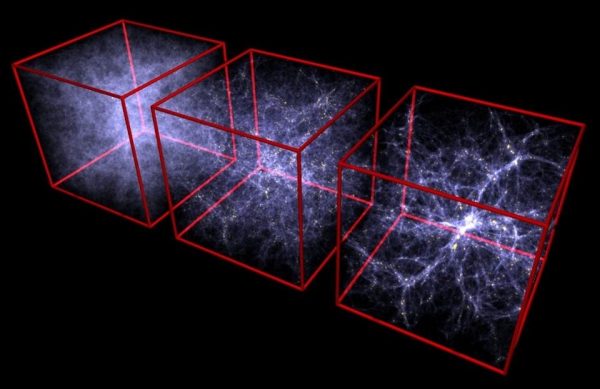
Illustration showing snapshots from a simulation by astrophysicist Volker Springel of the Max Planck Institute in Germany. It represents the growth of cosmic structure (galaxies and voids) when the universe was 0.9 billion, 3.2 billion and 13.7 billion years old (now). Image via Volker Springel/ MPE/ Kavli Foundation. [7]
Rather voids, like galactic filaments, take time to form by the Lambda-CDM model. Initially, voids started out small and evenly distributed throughout the very early universe. Repelling galaxies, because of their anti-gravity effect, volumes of void are attracted to each other. Behaving like soup bubbles merging to form a larger single bubble these volumes of void grew bigger and bigger over time merging into larger and larger voids.
This behaviour can be seen in the figure above which shows a simulation, by astrophysicist Volker Springel of the Max Planck Institute, based on the Lambda-CDM model. At 0.9 billion years the simulation shows a mostly homogenous volume of matter. Evolved at 3.2 billon years the simulation shows that voids have aggregated together along with galaxies forming protoclusters of galaxies. By 13.7 billion years the simulation that much larger voids have now formed and the galaxies form superclusters.
And yet the Cosmic Microwave Background Radiation shows a massive cold spot in the southern hemisphere indicating the presence of a supervoid measuring about a billion light years in diameter. If voids take time to form, as via the Lambda-CDM model, then how does it account for the presence of this supervoid only 200,000 years after the Big Bang event?
From my point of view, it cannot! In fact, I would say that in itself that is evidence enough to disqualify the precious cosmological principle that the distribution of matter is both homogenous and isotropic in the early universe.
The Big Bang Hypernova Hypothesis on the other hand accounts for the mostly homogenous and isotropic distribution of matter through the irrotational vortex jets that form in the hypernova of a MacLean. For the exact same reasons as you’d stir tea when adding milk, to create an irrotational vortex in the cup, to create a homogenous and isotropic mixture; so too was it for our early universe.
However the MacLean is a finite. That is the MacLean being a massive starlike object in the SuperVerse is not infinite in size but finite. Thus the resultant output ejection arising from the formation of two jets is itself also finite. Thus our universe, being one of the result jets, is itself finite. We already know the universe is most definitely finite in time as it had a beginning in the Big Bang event. The CMB radiation is evidence of that event.
Now I have already made the case for the formation of the Bootes Supervoid. That being the Bootes Supervoid exists because of a MacLean in the SuperVerse was in the path of the jet-a-verse that is our universe. As gravity imbues solidity in the SuperVerse then our universe flowed around it; enveloping it as water flows around a stone in a stream.
However this is not the case in the formation of the Eridanus Supervoid, the CMB Cold Spot. The MacLean that was previously there being the exact object that went hypernova and gave birth to our universe. Rather to account for the formation of the Eridanus Supervoid we look at the results of my first computational model.
In describing my first computational model we looked at how it gave rise to giving explanation to two key features that have been identified in analysis of the CMB radiation. Firstly, the straight edge vertices of the concentric cones gives us an explanation for why the universe at the largest scale is flat, as measured from analysis of the CMB. Secondly, we can identify the reason for seeing concentric circles, as identified by Penrose, on the CMB in the formation of a series of concentric ringed vortices in the model. [8] [9]
Particle animation of model that shows the individual particles as bubbles in a liquid medium. You can download the Blender model file by clicking this link.
Here we now account for how the computational model explains the formation of the CMB Cold Spot. As said, the MacLean is a finite starlike object and thus the volume of the material that makes up the jet itself is finite. The model reflects the matter inside the hypothetical MacLean object by the particles initial starting position being inside the volume of a sphere. The initial trajectory of the particles outwards in a uniform direction normal to the sphere is analogous to the core-bounce event that fundamentally is the actual reaction that causes a star to go nova.
As the particles move they are effected by the single magnetic force field defined in the model. The magnetic field lines are either open or closed dependant upon their location to the defined magnetic field. Field lines are closed to the equatorial regions and thus any particles in this location are caught in a circular orbit, following the direction dictated to it by the closed field lines.
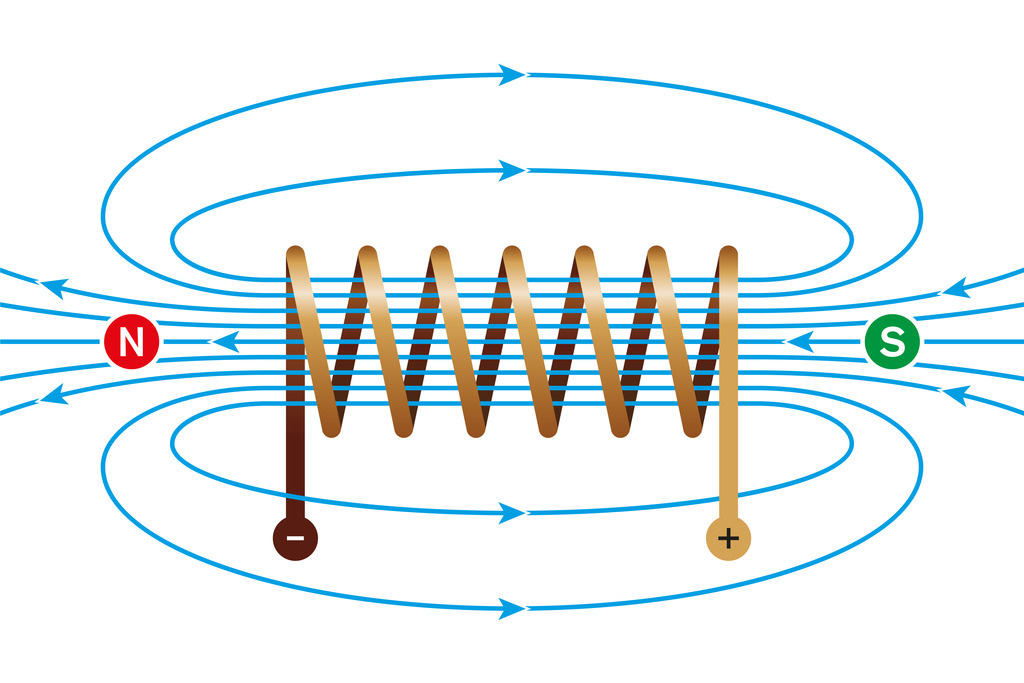
Magnetic field around a solenoid
Field lines, close to the magnetic polar regions, are open and thus any particles in this location follow a helical escape path away from the initial spherical volume. Thus the initial formation of the jet starts with the particles whose location was originally in the magnetic polar region. Then as the model evolves, those particles initially following a circular orbit on a closed field line ends up being fed into the magnetic polar region. At this point the particle follows the open field line following a helical escape path into becoming part of the jet itself. [10]
Particle animation of model that focuses on the initial jet formation and the subsequent void that develops as the jet moves away. In this model we add an additional point force field to act as the explosive force of the supernovae event. This is particularly to demonstrate how a supervoid can develop at the end of the jet’s formation. You can download the Blender model file by clicking this link.
In this animation of my computational model the spherical volume, noted by the magenta coloured spherical wireframe, is shown. The camera position and its point of view are fixed. The blue particles are exploded of from the sphere uniformly such that those on the closed field lines are quickly swept into the open field lines allowing them to form part of the jet.
You can see that as the model evolves the density of the particles in the jet becomes fairly uniformly distributed for any of the given concentric vortices.
However once all the particles have been caught by the open magnetic field lines forming a concentric jet; that whole jet travels away from the starting spherical position. In effect a void opens up between the jet and the spherical starting point. You can see that the particles in the jet are fairly uniformly distributed right up to the end of the jet where they rather abruptly stop.
Now it is important to note that we can view the spherical starting position as being inside our own actual universe. The reasoning for this comes from General Relativity and is something I briefly touched upon in my essay describing the exact specific pattern that constitutes a hypernova event.
In a hypernova of massive star the core-collapses infinitely upon itself and a rotating black hole is born. Following the same pattern the hypernova of a MacLean gives birth to the equivalent of a rotating black hole in the SuperVerse. Following the logic dictated to us via a maximally extended Penrose Diagram then on the other side of this black hole is its mirror opposite a White Hole. This I believe is the very fundamental reason for why our universe is in fact separate from the SuperVerse. [11]
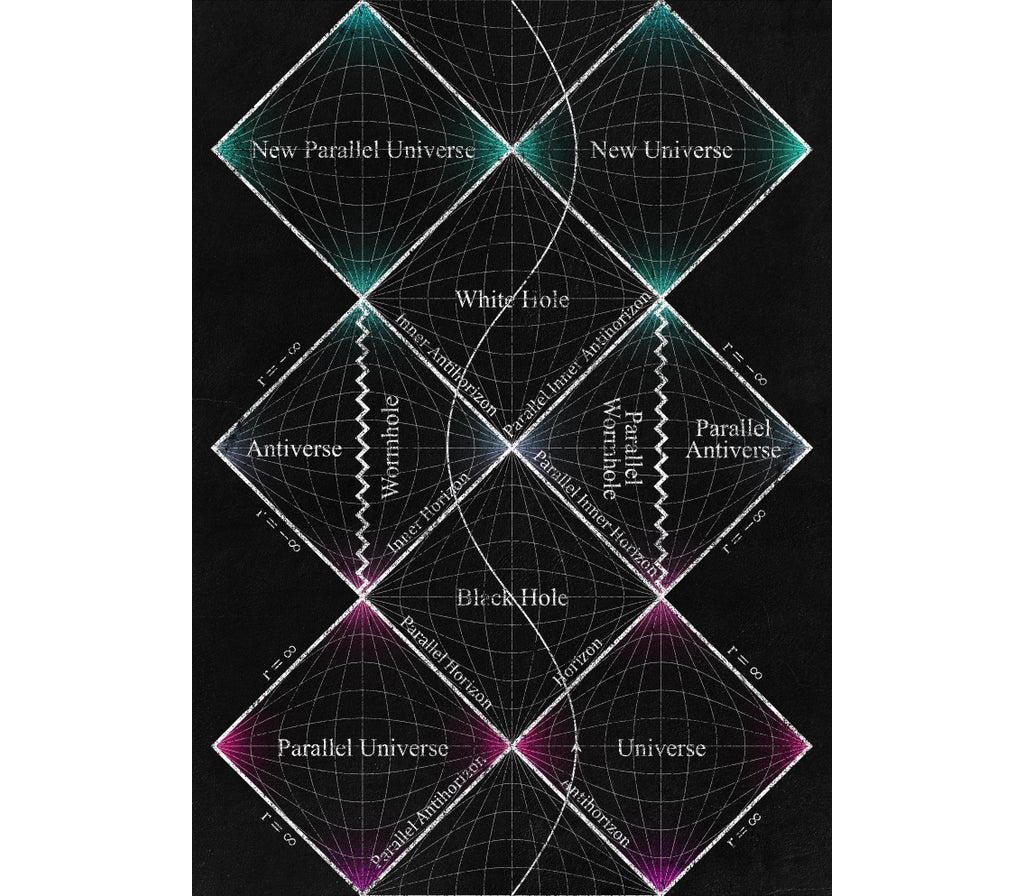
Maximally extended Penrose Diagram of the Kerr geometry of a rotating black hole. [11]
Also by the Penrose-Hawking Singularity Theorems we know that a gravitational singularity is required by the Big Bang theory itself. The mistake was in thinking about it in terms of the first and simplest solution; namely the Schwarzschild metric. Rather the correct solution would be to employ the Kerr metric such that a ringed wormhole singularity is the connection between the SuperVerse and our universe. [12] [13]
However unlike how we currently thinking about wormholes in the context of spanning interstellar distances this new vision of a wormhole is different. Both the entrance and exit of the wormhole is connected in the same single location and point in time. This makes perfect sense given that the collapsing core of the MacLean did not go anywhere but down on itself. In effect turning the fabric of spacetime of the SuperVerse inside out such that it is ejected out into becoming our own universe.
Off course, this is a topic I’ve barely begun to unpack and will be a main focal point of my research in the years to come.
But the main point to take away here for the moment is that the volume of space between the end of the jet and the white hole, located in the centre of the collapsed MacLean, are connected. Thus it forms a volume of space inside our own universe.
Hence we can see the formation of a supervoid in our universe as being between the end of the jet and the white hole. It is this volume of supervoid that is to us the Eridanus Supervoid which forms the Cold Spot on the Cosmic Microwave Background Radiation.
Thus the Big Bang Hypernova Hypothesis accounts for the Cold Spot on the CMB.
And its as simple as that.
Until next time.
References:
- [1] Detection of a non-Gaussian Spot in WMAP - M.Cruz, E.Martinez-Gonzalez, P.Vielva and L.Cayon
- [2] Planck 2013 results. XXIII. Isotropy and statistics of the CMB (5.9. The Cold Spot) - Planck Collaboration
- [3] Astronomers discover what might be the largest known structure in the universe that leaves its imprint on cosmic microwave background radiation. - University of Hawaii
- [4] Vast cosmic voids merge like soap bubbles - Nature
- [5] The Sticky Geometry of the Cosmic Web - Johan Hidding, Rien van de Weygaert, Gert Vegter
- [6] Cosmic Voids, Much Ado About Nothing - Rien van de Weygaert
- [7] What is dark energy? - Andy Briggs
- [8] A Flat Universe from High-Resolution Maps of the Cosmic Microwave Background Radiation : P. de Bernardis, P.A.R.Ade, J.J.Bock, J.R.Bond, J.Borrill, A.Boscaleri, K.Coble, B.P.Crill, G.De Gasperis, P.C.Farese, P.G.Ferreira11, K.Ganga, M.Giacometti, E.Hivon, V.V.Hristov, A.Iacoangeli, A.H.Jaffe, A.E.Lange, L.Martinis, S.Masi1, P.Mason, P.D.Mauskopf, A.Melchiorri, L.Miglio, T.Montroy, C.B.Netterfield, E.Pascale, F.Piacentini, D.Pogosyan, S.Prunet, S.Rao, G.Romeo, J.E.Ruhl, F.Scaramuzzi, D.Sforna, N.Vittorio
- [9] Concentric circles in WMAP data may provide evidence of violent pre-Big-Bang activity. V. G. Gurzadyan1 and R. Penrose
- [10] Motion of a Charged Particle in a Magnetic Field - University of Saskatchewan
- [11] Penrose diagrams
- [12] The 1965 Penrose singularity theorem - Roger Penrose
- [13] The Large Scale Structure of Space-Time - S.Hawking